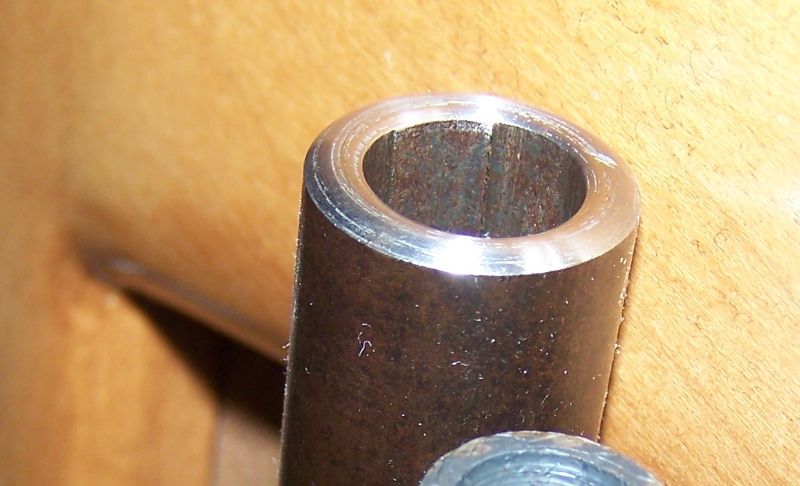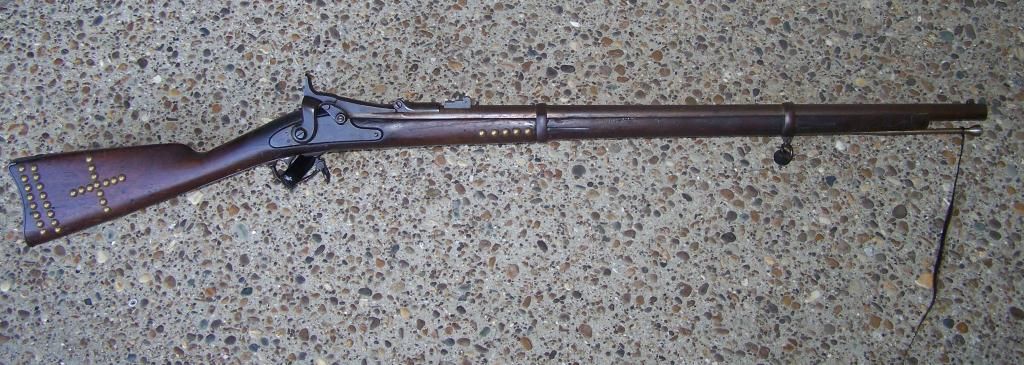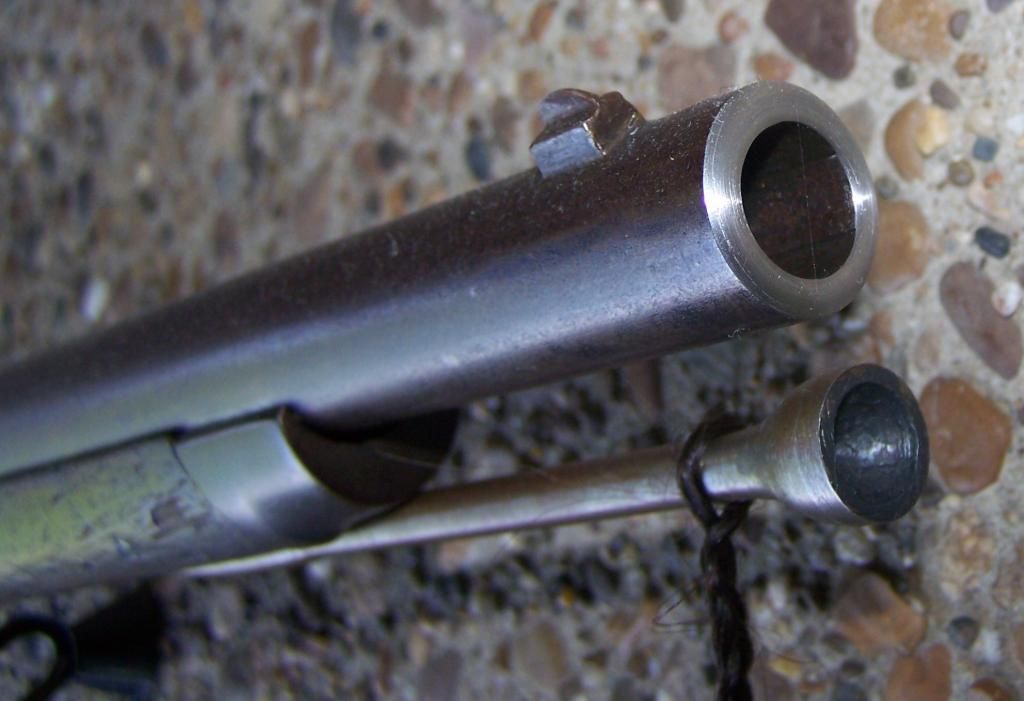

 The Accurate Reloading Forums
The Accurate Reloading Forums  THE ACCURATE RELOADING.COM FORUMS
THE ACCURATE RELOADING.COM FORUMS  Rifles
Rifles  Black Powder Cartridge Rifles
Black Powder Cartridge Rifles  Advice-50-70 Trap Door
Advice-50-70 Trap DoorGo  | New  | Find  | Notify  | Tools  | Reply  |  |
| one of us |
Butch, the added dimension here is that the parent musket may have seen combat in the Civil War before it became the Allen Conversion. What's not to love? There is hope, even when your brain tells you there isn’t. – John Green, author | |||
|
| One of Us |
I shoot a 50/70 Shiloh sharps and it is surprisingly pleasant to shoot, though my gun is heavier than what you are contemplating. NRA Patron member | |||
|
| One of Us |
Guys, I looked it over. The date on the lock is 1864. It either has no rifling or is smooth worn out. I think I will back off of it as I have a few wall hangers already. | |||
|
| One of Us |
Locks and stocks from the Civil War muskets were used in making the 1865, 1866, 1868, and 1870 Trapdoors. The lock date does not tell you the date of manufacture. Blocks on the 68 and 70 were marked with date of manufacture. | |||
|
| one of us |
Butch, that's disappointing. For what it is worth, these can be relined. I had a .45-70 Trapdoor with very little rifling left, had it relined in .40 caliber and chambered to .40-82. Wish I hadn't been talked out of it. There is hope, even when your brain tells you there isn’t. – John Green, author | |||
|
| one of us |
That's too bad about the bore. I have some 3-groove, 1:42"-twist, .515"-grooved rifling left in my "Second Allin Alteration" 50-70 Govt:  It is a shooter. But it was abused in other ways. Sumbuddy decorated the stock with tacks before I got her for $395. I had it re-crowned, and had the cracked stock epoxied and pinned.  The side plate is marked 1864 from the percussion conversion to this Model 1866 Trapdoor. Barrel length from breech to muzzle is now 28-7/8", 31-3/4" including the breech block. The recrowning I had done was just enough to clean it up. I bought another one of these that has an 1865 side plate and appears to be all original with no tacks, got it for only $300. But it has a lousy bore and similarly cracked stock. It is a wall hanger/parts donor for the shooter if ever need be. And its barrel is 29" long from breech to muzzle. So my junker is only about 1/8" longer-barreled than my re-crowned shooter. I am no scholar on these things and wonder if someone shortened the barrels and changed the rifles from 3-band to 2-band? So, 29" barrel and including the breech block, just under 32": Is that shorter than an original 1866? Front sight looks original too, same distance from breech. Is this original barrel length, other than re-crowning?  There is more than one way to skin a wildcat. | |||
|
| one of us |
Rip, you must just feel good have those two at hand. There is hope, even when your brain tells you there isn’t. – John Green, author | |||
|
| one of us |
Yes, Bill, thanks, Lucretia and her sister are good ol' gals. Sis is hanging on for organ donation if needed. How about the 1866's as original, 2-band or 3-band? Both variants? 29" barrel (not including breech block) or longer? Both? (To Google or to find a book? I says to me self.) There is more than one way to skin a wildcat. | |||
|
| one of us |
Well it appears that both of my rifles are "parts rifles" or cut down to approximate "cadet rifle" barrel length. That might have involved converting a 3-band stock to a 2-band, or relocating the bands on a shortened 2-band stock, and relocating the front sight rearward from the portion of the barrel that was amputated. Model 1866, both 3- and 2-band versions, were not serially numbered. Serial numbers started with the Model 1868. Model 1866's have a 13.5" LOP for standard rifle, though cadet rifles had a 12.5" LOP. My locks are standard rifle not cadet rifle, another distinction. The 1866 Cadet rifles have a thinner lock plate marked "1867" and are the only Springfield Armory arm to bear that date. Mine are marked "1864" and "1865" on the former percussion lock plates, and "1866" on the breech blocks. So it appears I have early American antiques, sporterized ex-military rifles. Sometime after 1866 a gunsmith sporterized my rifles. Whether in his garage in 1999 or his blacksmith shop in 1899, or on the rez who knows when. Whenever it was, Bubba struck again! And he added brass-tack decoration plus human hair wind guage, unless Chief Makes Big Thunder did that at the reservation gunshop. I referred to The .58- and .50- Caliber Rifles & Carbines of the Springfield Armory 1865-1872 by Richard A. Hosmer, from the For Collectors Only series by North Cape Publications, Inc. 1. U.S. MODEL 1865 .58 CALIBER SPRINGFIELD RIFLE (aka "FIRST ALLIN ALTERATION") 3-band stock barrel 37-5/8" in bore, 3 grooves, twist 1:72" RH muzzle diameter .775" 2. U.S. MODEL 1865 .58 CALIBER SPRINGFIELD CADET RIFLE (aka MODEL 1865 RIFLE, TWO-BAND VARIATION) 2-band stock barrel 33-5/8" in bore, 3 grooves, twist 1:72" RH muzzle diameter .775" 3. U.S. MODEL 1866 .50-70 SPRINGFIELD RIFLE (aka "SECOND ALLIN ALTERATION") 3-band stock barrel 36-5/8" in bore, 3 grooves, twist 1:42" RH, barrels were lined muzzle diameter .775" 4. U.S. MODEL 1866 .50-70 Caliber "SHORT RIFLE" (aka MODEL 1866 Rifle, TWO-BAND VARIATION) 2-band stock barrel 32-5/8" in bore, 3 grooves, twist 1:42" RH, barrels were lined muzzle diameter .775" 5. U.S. MODEL 1866 .50-55 SPRINGFIELD CADET RIFLE (aka U.S. MODEL 1867 .50-55 SPRINGFIELD CADET RIFLE) 2-band stock barrel 29-5/8" in bore, 3 grooves, twist 1:42" RH, barrels were lined muzzle diameter .742" 6. U.S. MODEL 1868 .50-70 SPRINGFIELD RIFLE 2-band stock barrel 32-5/8" in bore, 3 grooves, twist 1:42" RH, a few barrels were lined in early production, all others were newly manufactured as unlined barrels muzzle diameter .775" 7. U.S. MODEL 1869 .50-55 SPRINGFIELD CADET RIFLE 2-band stock barrel 29-5/8" in bore, 3 grooves, twist 1:42" RH, barrels were lined muzzle diameter .745" 8. U.S. MODEL 1870 .50-70 SPRINGFIELD RIFLE 2-band stock barrel 32-5/8" in bore, 3 grooves, twist 1:42" RH muzzle diameter .775" 9. U.S. MODEL 1870 .50-70 SPRINGFIELD CARBINE 1-band stock barrel 22" in bore, 3 grooves, twist 1:42" RH muzzle diameter .789" That's it in this book for .50-70 Trapdoors. Bubba-ed relics were not covered. Maybe I could make a 1-band carbine out of my donor rifle with 29" barrel, I might find some decent rifling somewhere in that barrel if I cut it down to an authentic-for-carbine 22 inches of bore. I might have another job for Bubba. I found that first "deluxe" rifle at Whittaker Guns in Owensboro, KY and the junker in Lexington, KY, 200 miles away. Bubba gets around. There is more than one way to skin a wildcat. | |||
|
| One of Us |
Picked it up today for $300. I left it in the floorboard of the car. I will try to remember to get it out tomorrow. | |||
|
| one of us |
Butch, nice job, man. Can't wait to see photos. There is hope, even when your brain tells you there isn’t. – John Green, author | |||
|
| Powered by Social Strata | Page 1 2 |
| Please Wait. Your request is being processed... |
|

Visit our on-line store for AR Memorabilia

